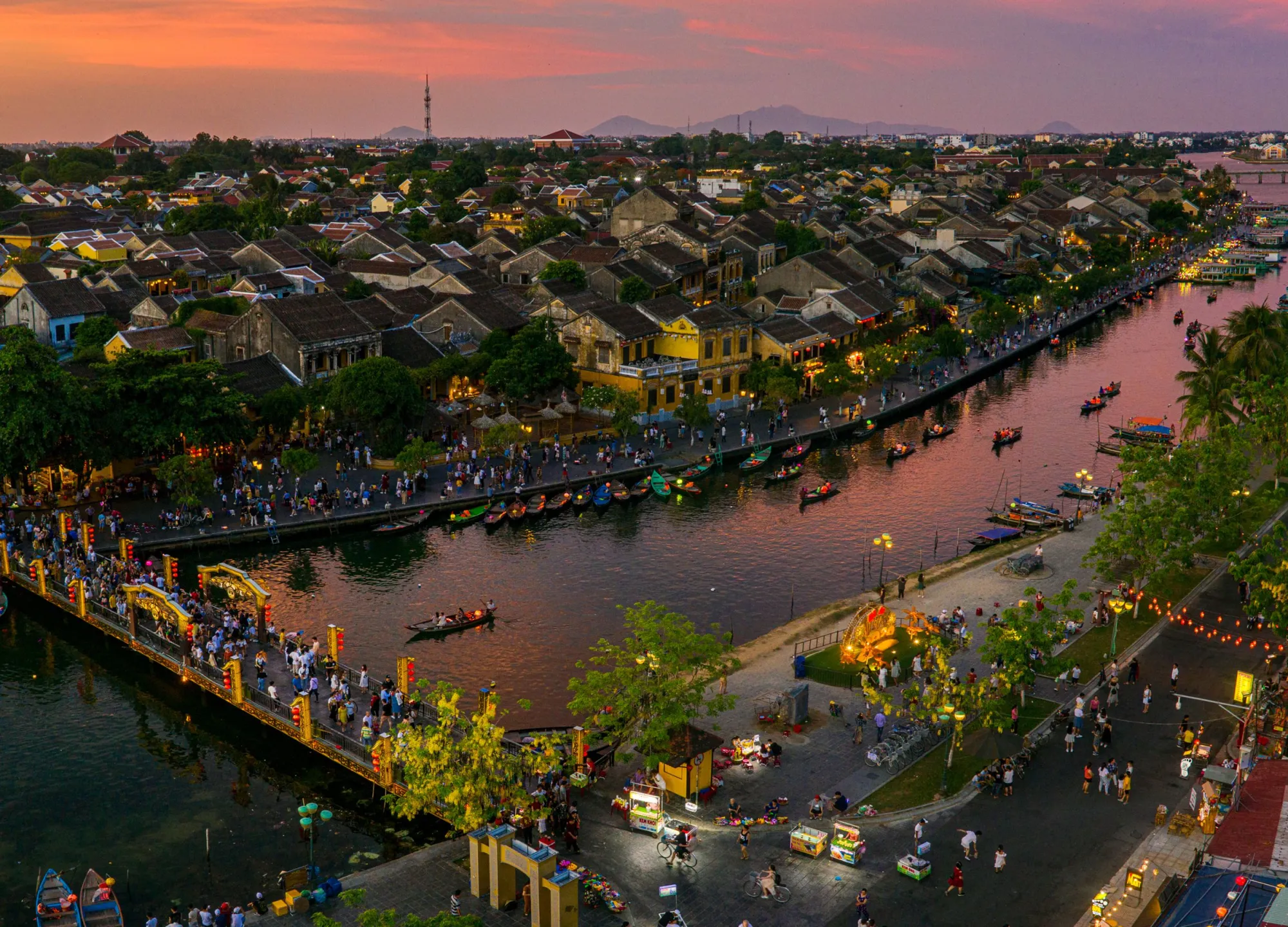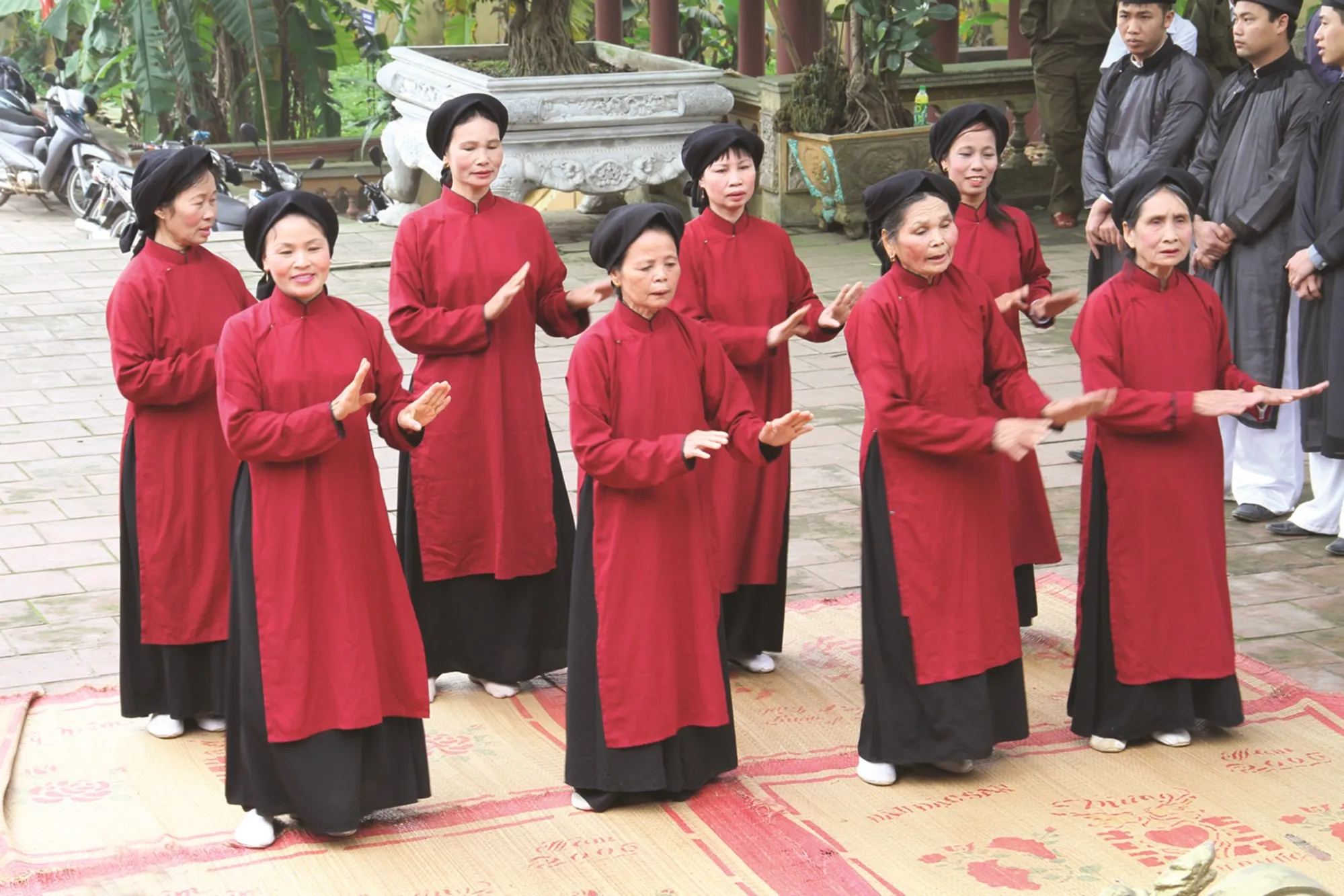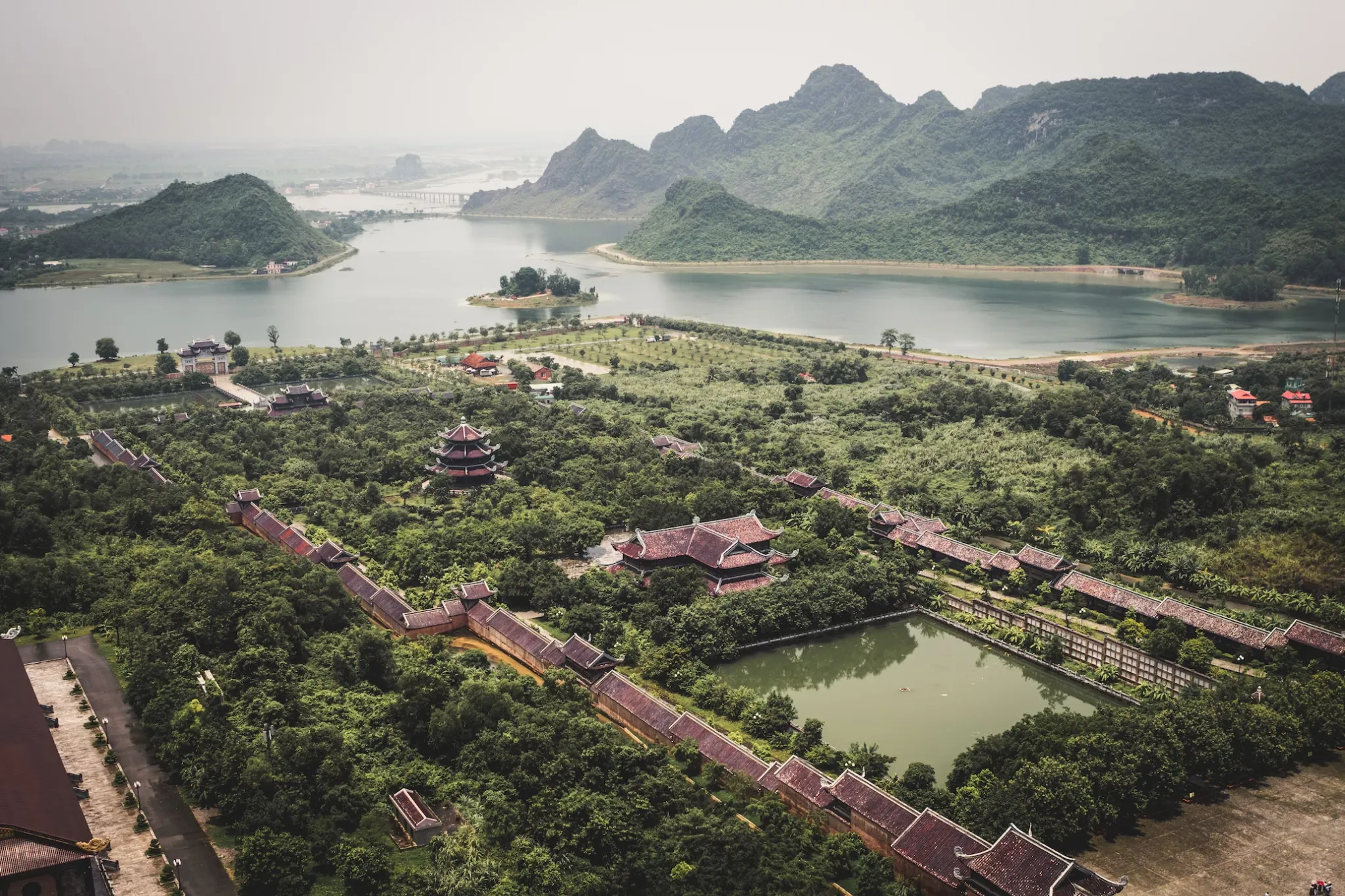Vietnam, with its rich natural beauty and long history and culture, is a treasure trove of invaluable heritage. UNESCO World Heritage sites in Vietnam are not only a source of pride for the Vietnamese people but also an attractive destination for international tourists, a convergence of unique history, culture, and nature.
1. UNESCO Tangible Cultural Heritage Sites in Vietnam
Architectural works, historical relics, and tangible cultural landscapes are vivid evidence of the country’s development process. Vietnam is proud to possess many tangible cultural heritages recognized by UNESCO, each location carrying its own story and unique value.
1.1 Hoi An Ancient Town – A Flourishing Trading Port
Hoi An Ancient Town, a bustling trading port from the 17th to 19th centuries, is one of Vietnam’s cultural heritages recognized by UNESCO in 1999. Located on the banks of the Thu Bon River, Hoi An captivates visitors with its ancient houses, mossy tiled roofs, and narrow streets adorned with shimmering lanterns. In Hoi An, visitors not only admire the unique architecture but also experience the slow, peaceful life of the local people.

1.2 My Son Sanctuary – Mysterious Champa Kingdom
My Son Sanctuary, an ancient Cham temple complex, is a testament to a brilliant civilization that once existed in central Vietnam. Recognized by UNESCO as a World Cultural Heritage Site, My Son is a treasure trove of Cham architectural art, reflecting the cultural exchange between Hinduism and indigenous culture. In My Son, visitors will admire unique architectural works, exquisite sculptures, and explore the mysteries of the Champa kingdom.
1.3 Complex of Hue Monuments – Imprints of the Nguyen Dynasty
The Complex of Hue Monuments, the capital of the Nguyen Dynasty from the 19th to mid-20th centuries, is a massive complex of historical and cultural relics, including the Imperial City, tombs of Nguyen emperors, pagodas, and other architectural works. Recognized by UNESCO as a World Cultural Heritage Site, the Complex of Hue Monuments is a symbol of feudal power, reflecting the sophistication of architecture and royal art. Visitors to Hue will travel back in time, learn about the history of the Nguyen Dynasty, and admire the ancient and solemn beauty of the architectural works.
1.4 Imperial Citadel of Thang Long – Witness to a Thousand Years of History
The Imperial Citadel of Thang Long, the center of power in Vietnam through many dynasties, is an important historical and cultural complex, a testament to Hanoi’s thousand-year history of civilization. Recognized by UNESCO as a World Cultural Heritage Site, the Imperial Citadel of Thang Long is a treasure trove of archaeological relics, architecture, and art, reflecting the development of Hanoi through historical periods.
1.5 Citadel of the Ho Dynasty – Unique Architecture
The Citadel of the Ho Dynasty, built in the 14th century, is a unique military architectural work, demonstrating the creativity and construction techniques of the ancient Vietnamese people. Recognized by UNESCO as a World Cultural Heritage Site, the Citadel of the Ho Dynasty is a testament to the development of Confucianism and citadel architecture in Vietnam.
2. UNESCO Intangible Cultural Heritage Sites in Vietnam
Besides tangible heritages, Vietnam also possesses a rich and diverse treasure of intangible cultural heritage, including music, arts, festivals, beliefs, and social customs. These heritages are symbols of national cultural identity, passed down from generation to generation.
2.1 Hue Royal Court Music – Academic Music
Hue Royal Court Music, the academic music of the Nguyen Dynasty, is a unique intangible cultural heritage, demonstrating sophistication in music and performing arts. Recognized by UNESCO, Hue Royal Court Music is a symbol of Vietnamese court culture, which needs to be preserved and promoted.
2.2 Space of Gong Culture in the Central Highlands – Echoes of the Mountains and Forests
The Space of Gong Culture in the Central Highlands, a unique intangible cultural heritage of ethnic minorities in the Central Highlands, is a symbol of community cohesion and the connection between humans and nature. Recognized by UNESCO, the Space of Gong Culture in the Central Highlands is a treasure trove of music, festivals, and social customs that need to be preserved and promoted.
2.3 Quan Ho Folk Songs – Love of the Kinh Bac People
Quan Ho folk songs, a unique folk art form of the Kinh Bac region (Bac Ninh, Bac Giang), are a symbol of love, friendship, and community cohesion. Recognized by UNESCO, Quan Ho folk songs are a precious intangible cultural heritage that needs to be preserved and promoted.

2.4 Ca Tru – Academic Music Heritage
Ca Tru, a traditional art form combining music and poetry, is a unique intangible cultural heritage of Vietnam. Recognized by UNESCO, Ca Tru is a symbol of sophistication in Vietnamese culture that needs to be preserved and promoted.
2.5 Giong Festival – Martial Spirit
Giong Festival, a traditional festival held annually in many localities in Vietnam to commemorate Saint Giong, a hero who contributed to driving away foreign invaders. Recognized by UNESCO, Giong Festival is a symbol of patriotism, martial spirit, and the strength of national unity of the Vietnamese people.
2.6 Xoan Singing of Phu Tho – Deity Worship
Xoan Singing of Phu Tho, a form of ritual singing dating back to the Hung Kings era, is a unique intangible cultural heritage of Vietnam. Recognized by UNESCO, Xoan Singing of Phu Tho is a symbol of ancestral worship and community cohesion.
2.7 Worship of Hung Kings – National Origin
Worship of Hung Kings, a traditional belief practice of the Vietnamese people to commemorate the Hung Kings, who founded the nation. Recognized by UNESCO, the worship of Hung Kings is a symbol of gratitude to ancestors and awareness of national origin.
2.8 Don Ca Tai Tu Music – Southern Folk Music
Don Ca Tai Tu music, a unique folk music form of the Southern region, is a unique intangible cultural heritage of Vietnam. Recognized by UNESCO, Don Ca Tai Tu music is a symbol of the creativity and optimistic spirit of the Southern people.
3. UNESCO Mixed Cultural and Natural Heritage Site in Vietnam
3.1 Trang An Landscape Complex – Harmonious Beauty
Trang An Landscape Complex in Ninh Binh is a unique mixed cultural and natural heritage, combining majestic natural beauty and long-standing historical and cultural values. Recognized by UNESCO, Trang An is an attractive destination for tourists with its picturesque mountains and rivers, historical and cultural relics, and diverse ecotourism activities.

4. UNESCO Memory of the World Heritage in Vietnam
4.1 Nguyen Dynasty Woodblocks – Massive Documentary Heritage
Nguyen Dynasty Woodblocks, a valuable collection of documents carved on wood during the Nguyen Dynasty, are a unique Memory of the World Heritage. Recognized by UNESCO, Nguyen Dynasty Woodblocks are an important source of information about the history, culture, and society of Vietnam under the Nguyen Dynasty.
4.2 Doctor Steles at Temple of Literature – Symbol of Encouraging Education
Doctor Steles at the Temple of Literature, stone steles inscribed with the names of doctors who passed exams during the feudal period, are a unique Memory of the World Heritage. Recognized by UNESCO, Doctor Steles at the Temple of Literature are a symbol of the tradition of studiousness and respect for talent of the Vietnamese people.
4.3 Nguyen Dynasty Royal Archives – Administrative Documents
Nguyen Dynasty Royal Archives, the system of administrative documents of the Nguyen Dynasty, are a unique Memory of the World Heritage. Recognized by UNESCO, Nguyen Dynasty Royal Archives are an important source of information about state management and territorial sovereignty of Vietnam under the Nguyen Dynasty.
UNESCO World Heritage sites in Vietnam are precious gems, contributing to enriching the national cultural identity and attracting tourists from all over the world. Exploring and preserving these heritages is the responsibility of every Vietnamese citizen, so that these cultural and historical values may last forever.